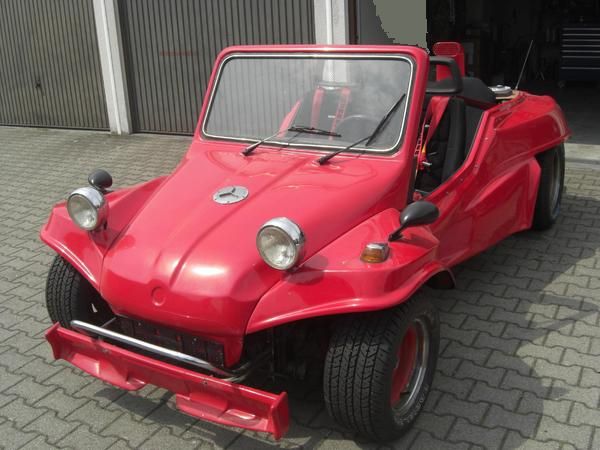The European automotive landscape of the 1980s witnessed a unique phenomenon — the rise of compact beach buggies that perfectly embodied the era’s spirit of freedom and adventure. Among these distinctive vehicles, the Albar Buggy S emerged as a compelling interpretation of the beach car concept, combining German engineering foundations with Mediterranean flair.
This compact two-door soft-top represented more than just a means of transportation. It showcased how European manufacturers could transform practical engineering into vehicles that captured the essence of coastal leisure, creating a distinct category that would influence automotive design for decades to come.
Design and Engineering Legacy
The Albar Buggy S stands as a masterpiece of efficient design, with its carefully considered dimensions of 3500mm length, 1870mm width, and 1250mm height. These proportions weren’t arbitrary — they resulted from a deliberate effort to create a vehicle that could navigate beach environments while maintaining stability and presence on regular roads.
The body design, featuring a distinctive soft-top configuration, exemplifies the practical sophistication of 1980s European automotive thinking.
“The Albar’s proportions and layout represented a perfect balance between form and function. It’s one of the few beach buggies that truly understood its purpose,” notes Marcus Reinhardt, vintage car restoration specialist at Classic Motors Munich.
The vehicle’s construction showcased attention to detail in areas that mattered most for its intended use. The lightweight body structure combined with strategic reinforcement points created a robust platform capable of handling various terrain types.
Fact!
The Albar Buggy S shared its platform with the Volkswagen Beetle, but its body was entirely unique, featuring custom-designed panels that were hand-finished at the factory.
Performance and Driving Experience
At the heart of the Albar Buggy S lies a 1584cc engine producing 37kW (50 hp), paired with a four-speed manual transmission. While these numbers might seem modest by today’s standards, they proved ideal for the vehicle’s intended purpose. The rear-wheel-drive configuration provided excellent traction in sandy conditions, while the power output ensured reliable performance without overwhelming the chassis.
Key performance features that defined the Albar Buggy S experience include:
- precise weight distribution enabling confident cornering behavior;
- responsive throttle control perfect for navigating varying terrain;
- direct steering feedback essential for beach driving scenarios;
- robust suspension system capable of absorbing coastal route imperfections;
- reliable braking performance even in challenging conditions.
The driving experience embodied the essence of casual motoring pleasure, prioritizing engagement over raw speed.
“I’ve driven countless beach buggies, but the Albar had a special connection with the road. It felt more sophisticated than its competitors,” shares Jean-Pierre Leblanc, vintage car collector.
Cultural Impact and Collectible Status
The Albar Buggy S emerged during a transformative period in European car culture. While American dune buggies had already established the concept, the Albar brought a distinctly European interpretation to the segment.
Historical Reference!
In the early 1980s, the Albar Buggy S gained unexpected cultural significance when renowned artist Joseph Beuys chose it as his personal vehicle, elevating its status from a recreational vehicle to an art world icon.
The vehicle’s influence extended beyond its immediate market, inspiring a generation of European automotive designers to think differently about recreational vehicles. Its presence in period films and advertisements helped establish it as a symbol of continental leisure lifestyle.
Current collectors particularly value original examples with documented history. The market has seen steady appreciation, especially for well-preserved units with original soft-tops and correct mechanical specifications.
Looking Back: A Time Capsule on Wheels
Today’s perspective on the Albar Buggy S reveals its significance as more than just another beach buggy. It represents a unique moment in automotive history when European engineering met lifestyle vehicle design in a particularly successful way.
Important!
Original Albar Buggy S models are increasingly rare, with experts estimating fewer than 50 complete examples remaining in roadworthy condition across Europe.
The vehicle’s design philosophy — emphasizing simplicity, functionality, and character — continues to influence modern recreational vehicle design. Its approach to combining practical engineering with lifestyle-oriented features provides valuable lessons for contemporary automotive designers.
The Verdict: Simple Sophistication
The Albar Buggy S stands as a testament to how thoughtful engineering and clear purpose can create something truly special. It never attempted to be everything to everyone, instead excelling in its intended role as a sophisticated beach companion.
The vehicle’s enduring appeal lies in its honest approach to automotive enjoyment, offering an experience that remains relevant and engaging four decades after its introduction.
Pros and Cons
| Advantages | Disadvantages |
|---|---|
| Exceptional balance of size and capability | Limited production numbers make parts scarce |
| Robust Volkswagen-based mechanicals | Paint quality issues on some examples |
| Distinctive European design aesthetic | Soft-top deterioration common with age |
| Strong collector value appreciation | Restoration can be complex and expensive |
| Excellent handling characteristics | Limited weather protection |
| Easy to maintain mechanical components | Not suitable for primary transportation |
| Unique cultural and historical significance | Rust-prone in certain areas |
The Albar Buggy S represents a high point in European recreational vehicle design. While it may have its limitations, its strengths far outweigh its weaknesses for the right owner. As both a usable classic and an investment opportunity, it continues to prove its worth in the modern collector car landscape.

